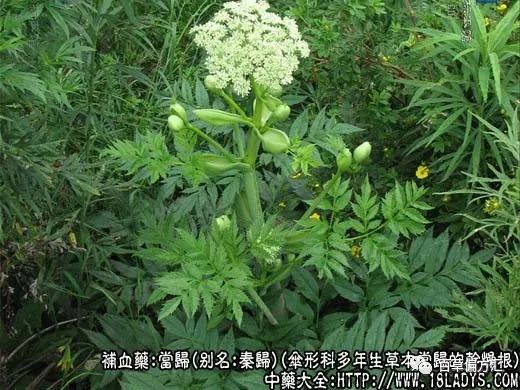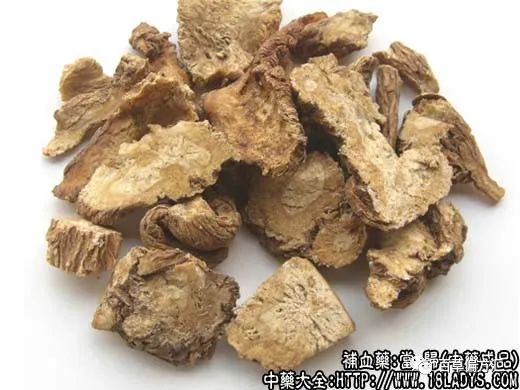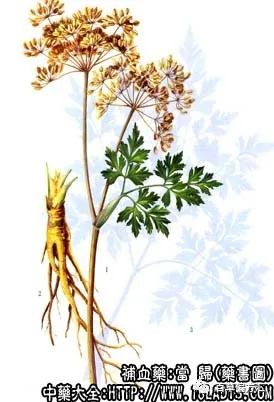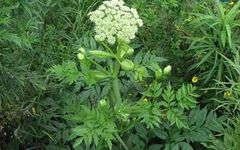


Angelica Sinensis (当归, Dāngguī) is a commonly used traditional Chinese medicine (TCM) herb, first recorded in the Shennong Bencao Jing (Shennong’s Classic of Materia Medica) and classified as a medium-grade herb.
Aliases: Qinguī, Xīguī.
Source: The dried root of the perennial herbaceous plant Angelica Sinensis from the Apiaceae family.
Production Areas: Mainly produced in Gansu Province, particularly in Min County, Dangchang, Wudu, Xihe, Lixian, and Wushan; also found in Yunnan, Sichuan, Shaanxi, Hubei, and Guizhou.
Identification: The main root is cylindrical or conical, with several to over a dozen lateral roots that are slightly twisted. The total length is 10-25 cm, with the main root measuring 2-7 cm in length and 2-3 cm in diameter, sometimes reaching 3.5 cm at the top. The upper diameter of the lateral roots is about 1 cm, tapering towards the end. The top has a distinct base scar, which is slightly raised or flat, often with remnants of the basal leaves. The epidermis is brownish or light brown, with the upper end of the main root having indistinct annular wrinkles, and the entire root exhibits tight longitudinal wrinkles and slightly raised pores. The texture is hard, becoming soft and pliable when moisture is absorbed, with a cross-section that is yellowish-white or light yellow-brown, featuring radial patterns, commonly referred to as “chrysanthemum heart”. The cambium is dark brown and annular. The xylem and phloem contain numerous small fissures and yellow-brown secretory cavities, with a white pith sometimes present at the center. The aroma is distinctive and fragrant, with a slightly bitter and spicy taste.
The best quality is characterized by a thick and long main root, few but robust lateral roots, and a surface that is yellow-brown, with a cross-section that is powdery white or light yellow-white.
Main Components: Contains volatile oils and a component that stimulates the uterus; also contains sucrose, vitamin B12, etc.
Efficacy and Functions of Angelica Sinensis
Functions: Nourishes blood, promotes blood circulation, moistens the intestines, regulates menstruation.
1. Adjusts uterine function. Animal experiments have confirmed that when the uterus is under internal pressure, Angelica Sinensis has a stimulating effect, making uterine contractions regular and strengthening contraction force; when there is no internal pressure, it has an inhibitory effect on the uterus.
2. Sedative and analgesic effects. The effective component is volatile oil.
3. Diuretic effect. The effective component is sucrose.
4. Anti-vitamin E deficiency.
5. Antibacterial effects. In vitro tests show inhibitory effects on Shigella, Salmonella, Escherichia coli, and hemolytic streptococcus.
Preparation: Can be sliced and used raw or stir-fried with wine, soil, or charred.
Properties: Sweet, bitter, spicy, warm.
Meridians Entered: Heart, Liver, Spleen.
Functions: Nourishes blood, invigorates blood circulation, regulates menstruation, moistens dryness, and promotes bowel movements.
Indications: Irregular menstruation, blood deficiency or blood stasis leading to amenorrhea, dysmenorrhea, excessive menstrual bleeding, trauma, abscesses, rheumatic pain, and constipation due to blood deficiency.
Clinical Applications: Angelica Sinensis is one of the most commonly used herbs in TCM. It is indicated for any condition requiring blood nourishment and circulation, whether it is a blood syndrome, deficiency syndrome, exterior syndrome, or abscess.
1. A key herb in gynecology, primarily used for regulating menstruation, with proven efficacy in dysmenorrhea, often combined with Bai Shao (白芍, White Peony) and Yan Hu Suo (延胡索, Corydalis). It also treats amenorrhea and irregular menstruation. In summary, various menstrual regulation formulas invariably include Angelica Sinensis for its blood-invigorating and analgesic effects (either enhancing uterine contractions to expel stagnant blood or relaxing uterine spasms to relieve pain), often combined with Shu Di Huang (熟地黄, Rehmannia), Chuan Xiong (川芎, Ligusticum), and Bai Shao to form the Si Wu Tang (四物汤, Four Substance Decoction). This is a fundamental formula for regulating blood, suitable not only for blood deficiency but also for various conditions of irregular menstruation and postpartum issues, which can generally be adjusted based on this formula.
2. Used for nourishing blood. For symptoms of heart blood deficiency such as palpitations, forgetfulness, insomnia, and anxiety, Angelica Sinensis nourishes blood to calm the spirit, as in the Angelica Sinensis Blood Nourishing Decoction; for symptoms of spleen blood deficiency leading to emaciation and sallow complexion, it nourishes blood to strengthen the spleen, as in the Si Wu Tang; for symptoms of liver blood deficiency causing dizziness, tinnitus, and muscle spasms, it nourishes blood to soften the liver, as in the Yi Guan Jian (一贯煎, One Thread Decoction).
3. Used to treat blood stasis in the limbs, especially for trauma and vascular diseases causing blood stasis or poor circulation and swelling. Angelica Sinensis has a blood-moving effect (improving circulation and relieving pain), hence it is commonly used in trauma formulas and those treating thrombotic occlusive vascular diseases.
4. Used to treat abdominal pain, particularly suitable for pain due to qi and blood stasis combined with deficiency-cold, such as postpartum abdominal pain, often combined with Jian Zhong Tang (建中汤, Constructing the Middle Decoction) to enhance warming and pain-relieving effects, as in the Angelica Sinensis Ginger Lamb Soup; or for pain due to stasis (such as early-stage dysentery with purulent blood diarrhea and abdominal pain or constipation-related abdominal pain in women), combined with Bai Shao and Xiang Fu (香附, Cyperus) for blood-invigorating and analgesic effects, as in the modified Angelica Sinensis Peony Powder.
5. Used to treat chronic abscesses, leveraging its blood-invigorating, blood-nourishing, and pain-relieving properties to improve circulation and enhance the body’s resistance, often combined with Huang Qi (黄芪, Astragalus) and Yin Hua (银花, Honeysuckle).
6. Used to treat dry intestines and constipation, particularly suitable for those with qi and blood deficiency, often combined with other herbs that nourish and promote bowel movements, such as Rou Cong Rong (肉苁蓉, Cistanche) and Niu Xi (牛膝, Achyranthes), as in the Ji Chuan Jian (济川煎, River Crossing Decoction).
Additionally, for exterior syndromes with qi and blood deficiency, or headaches and joint pain due to blood stasis, Angelica Sinensis can also be used for its blood-invigorating and analgesic effects.
Precautions: 1. It has been said that “the head of Angelica nourishes blood, the body nourishes the body, and the tail breaks blood, all are used for invigorating blood”; or “the head nourishes the head (including neck and chest), the body nourishes the body, and the tail nourishes the limbs”. However, in practice, it is not necessary to be overly strict. In clinical applications, the commonly sold Angelica Sinensis is generally supplied as a whole. If conditions permit, it can be subdivided according to the following principles: for improving blood circulation or when used in exterior-releasing formulas, the whole Angelica Sinensis is preferable; for treating anemia and regulating menstruation, the body is better; for treating trauma and swelling, or joint flexion and extension difficulties, the tail is preferable.
2. Long-term or excessive use of Angelica Sinensis may cause deficiency fire to rise, leading to symptoms such as sore throat and nasal burning; in such cases, it is advisable to add cooling and blood-clearing herbs like Yin Hua and Sheng Di (生地, Rehmannia) to the prescription.
3. Angelica Sinensis promotes bowel movements, so it is not suitable for those with spleen and stomach yang deficiency leading to diarrhea; if one usually has loose stools and needs to use Angelica Sinensis, it is advisable to add Bai Zhu (白术, Atractylodes) and Fu Ling (茯苓, Poria) to counteract its laxative effect.
4. Angelica Sinensis is warm in nature, so it is not suitable for those with lung deficiency and internal heat, liver fire, or those who have just stopped vomiting blood.
Usage of Angelica Sinensis
Dose: The common dosage is 9-12 g, preferably slightly higher, up to 12-30 g. For large doses, it can be used up to 60 g; for exterior syndromes, a small amount of 3-9 g is sufficient; for nourishing blood and improving circulation or treating constipation, such as in the postpartum blood deficiency Angelica Sinensis Ginger Lamb Soup, the dosage is usually above 30 g, while in the Angelica Sinensis Blood Nourishing Decoction, only 6 g is used to assist Huang Qi (黄芪, Astragalus) (the formula is named “Blood Nourishing”, but it actually nourishes qi to generate blood).
Example Formulas: 1. Angelica Sinensis Blood Nourishing Decoction (《内外伤辩惑论》): Angelica Sinensis 6 g, Huang Qi 30 g, decoct in water for oral administration.
2. Yi Guan Jian (《柳州医话》): Angelica Sinensis body 9 g, Bei Sha Shen (北沙参, Glehnia) 9 g, Mai Dong (麦冬, Ophiopogon) 6 g, Sheng Di 24 g, Gou Qi Zi (枸杞子, Goji Berry) 12 g, Chuan Lian Zi (川楝子, Melia) 4.5 g, decoct in water for oral administration.
3. Angelica Sinensis Jian Zhong Tang (《千金翼方》): Angelica Sinensis 12 g, Gui Zhi (桂枝, Cinnamon Twig) 6 g, Bai Shao 12 g, powdered Gan Cao (粉甘草, Licorice) 9 g, Sheng Jiang 3 g, Hong Zao (红枣, Red Dates) 15 g, maltose 30 g (dissolved), decoct in water for oral administration.
4. Angelica Sinensis Ginger Lamb Soup (《金匮要略》): Lamb 250 g, Angelica Sinensis 30 g, Sheng Jiang 15 g, steamed in water, taken warm, or decocted in water for oral administration.
5. Modified Angelica Sinensis Peony Powder: Angelica Sinensis 9 g, Bai Shao 12 g, Chuan Xiong 6 g, Bai Zhu 9 g, Fu Ling 9 g, Ze Xie (泽泻, Alisma) 9 g, Xiang Fu 6 g, Yan Hu Suo 6 g, decoct in water for oral administration.
6. Ji Chuan Jian (《景岳全书》): Angelica Sinensis 12 g, Niu Xi 6 g, Xian Rou Cong Rong (咸肉苁蓉, Cistanche) 4.5 g, Ze Xie 4.5 g, Sheng Ma (升麻, Cimicifuga) 2.4 g, Zhi Ke (枳壳, Bitter Orange) 3 g, decoct in water for oral administration.
Note: The product specifications have varied in the past, such as Hu Shou Gui, Yuan Lai Tou, Chang Xing Gui, Gui Tui, Gui Wei, etc. They are now simplified into grades 1-4 for Angelica Sinensis and grades 1-4 for the head, classified by the size of the roots. Grade 1 Angelica Sinensis has 20 roots per 0.5 kg or less, grade 2 has 33 roots or less, grade 3 has 55 roots or less, and grade 4 has more than 55 roots, with a maximum of 70% of the tail. The head of Angelica Sinensis (Hu Shou) grade 1 has 20 roots or less, grade 2 has 40 roots or less, grade 3 has 60 roots or less, and grade 4 has 80 roots or less.
This product from Gansu has better quality, with long main roots, fine skin, and solid texture. The Yunnan product has short and thick main roots, coarser skin, and a slightly inferior quality. Additionally, some regions also produce local Angelica Sinensis for local sale.
More Exciting Recommendations:
Traditional Chinese Herbs: The Efficacy of Perilla
Traditional Chinese Herbs: The Efficacy of Artemisia
Traditional Chinese Herbs: The Efficacy and Functions of Pinellia
Traditional Chinese Herbs: The Efficacy and Functions of Drooping Knotweed (6 Major Effects and Usage)
The above contentis sourced from the internet,for reference only,please delete if infringing!
Follow your physician’s advice! Do not self-medicate! Be the first to collect and share with friends,the more people see it, the more health benefits!
Be the first to collect and share with friends,the more people see it, the more health benefits!

